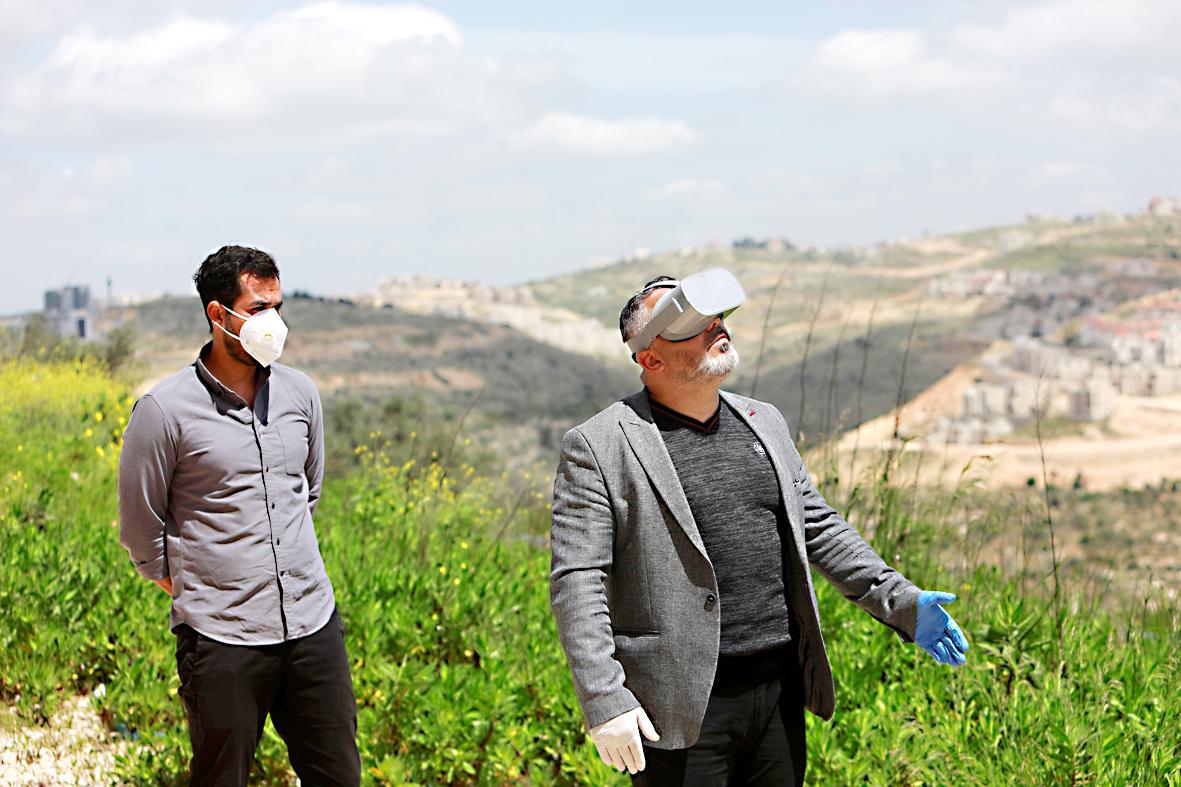Virtual reality tours have replaced flag-waving rallies as Palestinians facing COVID-19 restrictions create digital spaces to lament the loss of their physical homeland in 1948.
Cellphone apps and Zoom video chats are among the other online tools Palestinians are using to mark the Nakba, or “Catastrophe,” when they and their descendants were forced from their villages or fled in the war that surrounded Israel’s creation.
The Nakba was marked yesterday — the day after Israel’s Independence Day in the Western calendar.

Photo: REUTERS
Last year Israeli troops wounded nearly 50 Palestinians during Nakba protests, but rallies were cancelled this year. In the West Bank, Palestinian President Mahmoud Abbas authorized digital activities to mark the anniversary.
While the Palestinians still have no state on the ground, many are finding new ways to remember their past and express their identity online.
Palestine VR, a free app, is one of several new tools that aim in part to connect millions of diaspora Palestinians with their forefathers’ towns and villages, some of which now lie abandoned in Israel.
“Coming to Palestine is transformational, especially for Palestinians who aren’t allowed to visit,” said Ramallah-based Palestine VR founder Salem Barahmeh, 30, as he guided Zoom participants through the app’s 47 virtual tours of Gaza, Jerusalem and the West Bank.
“We want to share Palestine with them, and help them feel and understand this place.”
Majd al-Shihabi, a Palestinian refugee born in Syria, is part of a team that developed Palestine Open Maps, an interactive database of Palestinian villages and Jewish towns as they stood in 1948.
“Palestinians anywhere can see visual details of their villages, reinforcing our understanding of what Palestine was like before the exodus,” Shihabi, 31, said from Beirut.
The new initiatives highlight a “digital nation” that has also formed around Palestinian culture, food and fashion, according to activists and entrepreneurs.
Joudie Kalla, a Palestinian-British chef and author of Palestine on a Plate, says vigorous recipe debates amongst her 124,000 Instagram followers are evidence of a growing community.
“No one can stop Palestinians from connecting on social media — even if it’s impassioned discussion over whose village makes the best kibbeh,” Kalla, 42, said from London, referencing a traditional Arabic meat pie.
Palestinians want a state in the West Bank and the Gaza Strip with East Jerusalem as its capital. Israel captured and occupied those territories in the 1967 Middle East war, later annexing East Jerusalem in a move not recognized internationally and withdrawing from Gaza in 2005.
In 2012, the UN General Assembly approved the de facto recognition of the sovereign state of Palestine. But full Palestinian statehood has remained elusive.
Many Palestinians abroad fear losing touch with their roots.
This has prompted “fusion” projects that are transforming Palestinian fashion staples like the keffiyeh, a black or red-and-white checkered scarf now available in multiple colors.
Clothing company Threads of Palestine makes keffiyeh tee-shirts, hoodies, and onesies for babies, sourcing fabric from the West Bank’s last keffiyeh factory.
“The keffiyeh, it oozes with Palestinian culture,” said manager Abed al-Aziz al-Karaki at Hebron’s Hirbawi factory.

“Why does Taiwan identity decline?”a group of researchers lead by University of Nevada political scientist Austin Wang (王宏恩) asked in a recent paper. After all, it is not difficult to explain the rise in Taiwanese identity after the early 1990s. But no model predicted its decline during the 2016-2018 period, they say. After testing various alternative explanations, Wang et al argue that the fall-off in Taiwanese identity during that period is related to voter hedging based on the performance of the Democratic Progressive Party (DPP). Since the DPP is perceived as the guardian of Taiwan identity, when it performs well,

The Taiwan People’s Party (TPP) on May 18 held a rally in Taichung to mark the anniversary of President William Lai’s (賴清德) inauguration on May 20. The title of the rally could be loosely translated to “May 18 recall fraudulent goods” (518退貨ㄌㄨㄚˋ!). Unlike in English, where the terms are the same, “recall” (退貨) in this context refers to product recalls due to damaged, defective or fraudulent merchandise, not the political recalls (罷免) currently dominating the headlines. I attended the rally to determine if the impression was correct that the TPP under party Chairman Huang Kuo-Chang (黃國昌) had little of a

At Computex 2025, Nvidia CEO Jensen Huang (黃仁勳) urged the government to subsidize AI. “All schools in Taiwan must integrate AI into their curricula,” he declared. A few months earlier, he said, “If I were a student today, I’d immediately start using tools like ChatGPT, Gemini Pro and Grok to learn, write and accelerate my thinking.” Huang sees the AI-bullet train leaving the station. And as one of its drivers, he’s worried about youth not getting on board — bad for their careers, and bad for his workforce. As a semiconductor supply-chain powerhouse and AI hub wannabe, Taiwan is seeing

Jade Mountain (玉山) — Taiwan’s highest peak — is the ultimate goal for those attempting a through-hike of the Mountains to Sea National Greenway (山海圳國家綠道), and that’s precisely where we’re headed in this final installment of a quartet of articles covering the Greenway. Picking up the trail at the Tsou tribal villages of Dabang and Tefuye, it’s worth stocking up on provisions before setting off, since — aside from the scant offerings available on the mountain’s Dongpu Lodge (東埔山莊) and Paiyun Lodge’s (排雲山莊) meal service — there’s nowhere to get food from here on out. TEFUYE HISTORIC TRAIL The journey recommences with